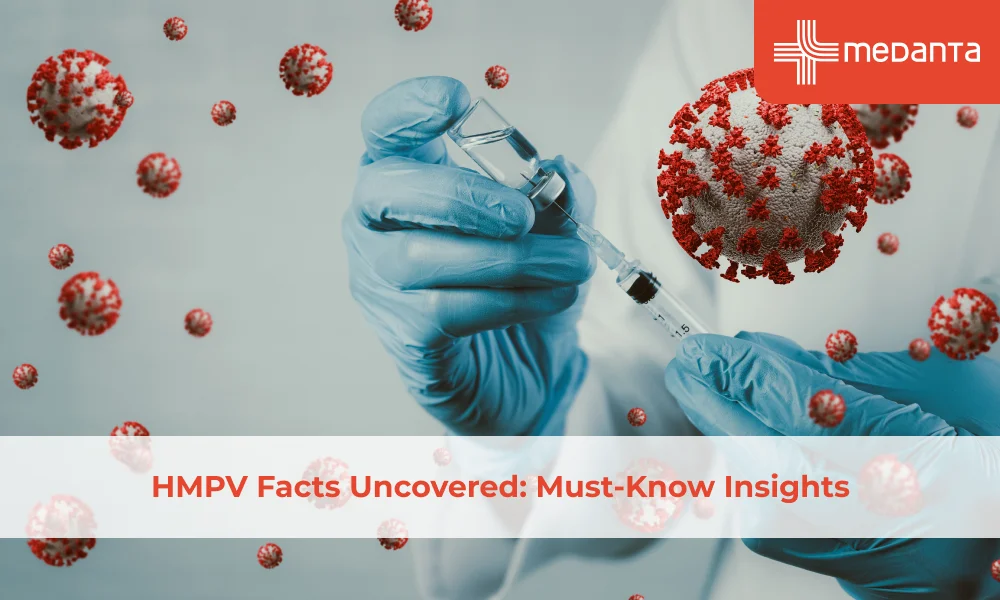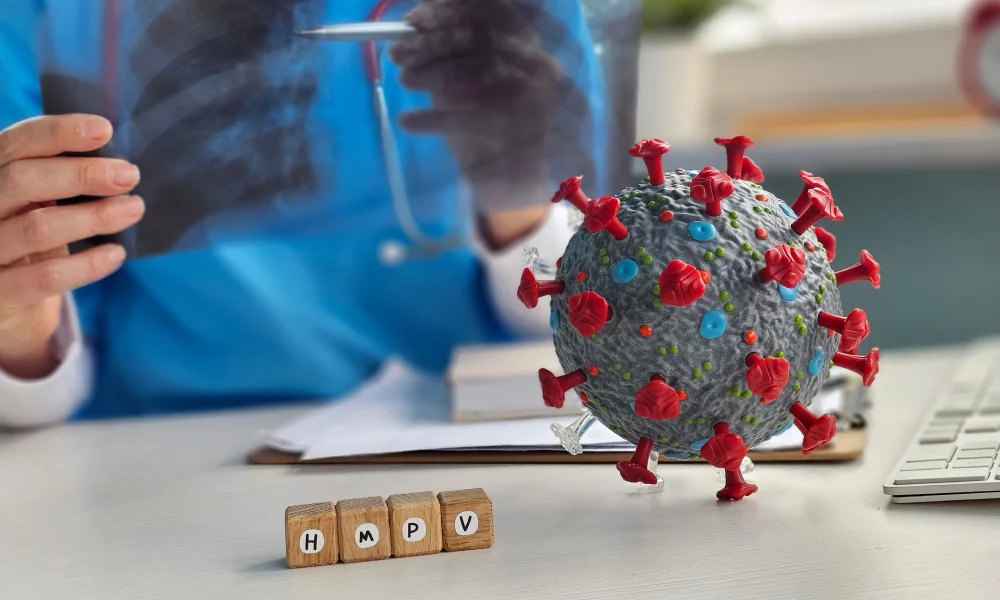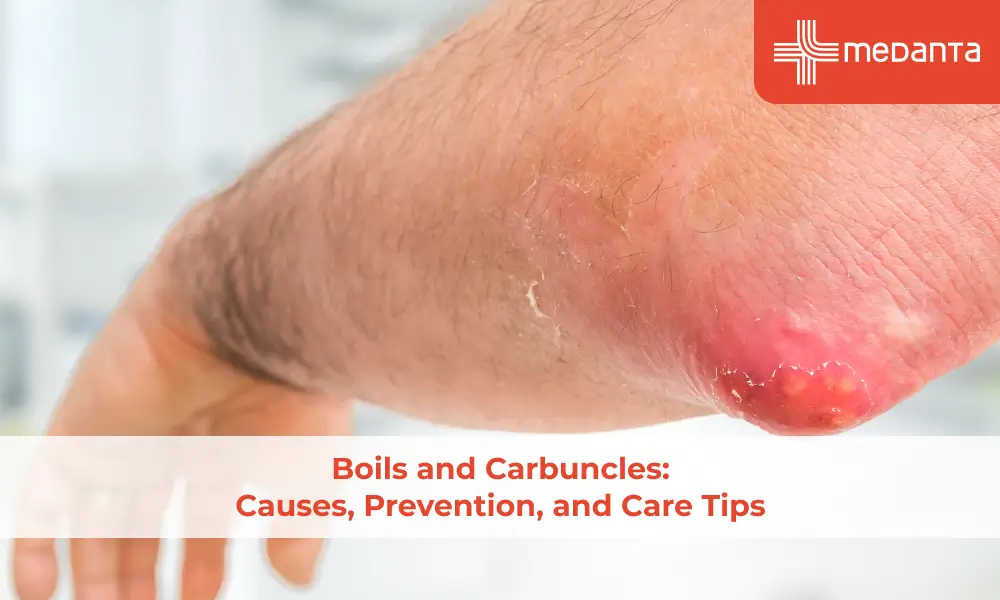HMPV Facts Uncovered: Must-Know Insights

TABLE OF CONTENTS
- Introduction
- What is Human Metapneumovirus (HMPV)?
- Symptoms of Human Metapneumovirus Infection (HMPV)
- How Serious is the Human Metapneumovirus Infection?
- Can Human Metapneumovirus Infection Cause Death?
- When is Human Metapneumovirus Contagious?
- Is Human Metapneumovirus Curable?
- How to Protect Yourself from HMPV?
- Final Words
- FAQs
The outbreak of human metapneumovirus in China has put the world on high alert. While HMPV may not be as famous as influenza and COVID-19, it is also a major respiratory virus. Though the virus is mild and self-limiting in the majority, it can sometimes be more severe in vulnerable groups such as children, the elderly, and those immunocompromised. Given the recent spread, it is important to understand the virus and how one can protect themselves.
In this blog post, we answer some frequently asked questions on HMPV, its symptoms, treatment, and how to prevent it.
What is Human Metapneumovirus (HMPV)?
Human metapneumovirus (HMPV) is a respiratory virus of the winter season. It was first identified in 2001 by a research team from the Netherlands, though it likely circulated in humans many years before discovery. HMPV belongs to the same family as the respiratory syncytial virus (RSV), which is well known for its ability to cause severe colds in infants and older adults.
Usually, HMPV will cause infections late in winter and into spring. This virus thrives in any closed contact setting; it spreads quickly throughout families, schools, and healthcare environments. Most diseases it causes are not dangerous, but it could cause pneumonia and bronchiolitis within a high-risk population.

Symptoms of Human Metapneumovirus Infection (HMPV)
The symptoms of human metapneumovirus infection can vary from mild to severe and, in many aspects, depending upon the age, health, and immune status of the individual. Common metapneumovirus symptoms include the following :
Cold
Cough
Runny nose
Nasal congestion
Sore throat
Low-grade fever
Here are some more serious symptoms
High fever
Shortness of breath
Wheezing
Chest pain
Fatigue
Severe cases of HMPV in the high–risk groups tend to lead to pneumonia or other bronchiolitis. If, by any chance, the symptoms of human metapneumovirus persist or get worse, then it is essential to consult a doctor.
How Serious is the Human Metapneumovirus Infection?
HMPV can vary from very mild to severe. Most healthy people have a mild, self-limiting illness resembling a common cold. However, in some populations, infection can be more serious.
The high-risk groups include :
Infants and Young Children: Their immune systems are immature and are prone to human metapneumovirus infection.
Older Adults: The weakening of the immune systems increases the likelihood of developing severe illness.
People with Chronic Conditions: The infection can exacerbate asthma, heart disease, or COPD.
Immunocompromised: those undergoing cancer treatments or living with HIV/AIDS. In some serious cases, HMPV infection may lead to death through secondary complications like ARDS.
Can Human Metapneumovirus Infection Cause Death?
HMPV-related deaths are rare but not uncommon. Complications may include the following as a result of serious infection:
Acute Respiratory Distress Syndrome-ARDS
Respiratory Failure
The said complications would also be more frequently encountered in high-risk persons, especially in older persons or those with serious underlying conditions. This is particularly where early diagnosis and proper management would come into play to ensure the prevention of such serious results.
When is Human Metapneumovirus Contagious?
HMPV is highly contagious, more so in its incubation and active phases. The incubation period is 4-6 days from exposure, during which time the virus may have already been passed on to others. Contagion remains until up to 2 weeks after infection, but the potential for it to spread is the highest in the first few days of the disease.
Here's how the disease is spread:
Via respiratory droplets: A person's sneeze or even talking is enough to aerosolise some virus-laden droplets to other people.
Contaminated Surfaces: HMPV can survive on surfaces like doorknobs, phones, and tables. Touching these and then touching one's face can cause infection.
Close Contact: Sharing utensils, kissing, or being in crowded places with an infected person can increase the risk of transmission of HMPV.
Understanding when HMPV is contagious will go a long way in enhancing prevention practices.
Is Human Metapneumovirus Curable?
Currently, there is no specific cure or antiviral drug for human metapneumovirus. Human metapneumovirus treatment involves the management of symptoms and supportive care for the body's immune system.
Self-care at home is enough for mild cases, which include:
Rest: Getting enough sleep will allow your body to fight the infection.
Fluids: Drinking lots of fluids helps your body avoid dehydration from fever and respiratory symptoms.
Over-the-counter Medications: Pain relievers like acetaminophen or ibuprofen can be used in the treatment of fever and discomfort.
Note: Using antibiotics for HMPV infection can sometimes be harmful. Hence, do not take antibiotics without consulting a doctor.
In severe cases, one may need to stay in the hospital. Human metapneumovirus treatment may comprise the following:
Oxygen Therapy
IV Fluids
Low-dose steroids
As there is no particular human metapneumovirus treatment, early diagnosis and supportive care are vital in the prevention of complications.
How Long Does HMPV Last?
The length of an HMPV infection typically lasts anywhere from 1-2 weeks, depending upon the general health and immune system of the host.
Mild Cases: The symptoms usually subside in a matter of 7-10 days.
Severe Cases: Recovery may be longer if there are any complications, such as pneumonia.
Even after the acute phase, some symptoms, like cough or fatigue, can last several weeks. Persons with lingering symptoms should follow up with a doctor to prevent secondary infections or complications.
Where Did HMPV Come From?
It was first discovered in 2001 by scientists in the Netherlands. Genetic analysis indicates it was adapted from bird metapneumoviruses, which then made the cross-species jump into the human population.
How to Protect Yourself from HMPV?
Here are some steps you can take to prevent yourself from the HMPV:
Practice Good Hygiene:
Wash your hands often with soap and water.
Use alcohol-based hand sanitizers if handwashing is not an option.
Avoid Close Contact:
Avoid persons with symptoms of respiratory illness.
Decrease physical contact, such as handshaking during outbreaks.
Clean Surfaces:
Clean commonly touched objects such as doorknobs, light switches, and cell phones frequently.
Use a Mask in Crowded Places:
Masks may help avoid breathing in respiratory droplets that are in the air in public places.
Strengthen Your Immune System:
Eat healthy food, exercise, and drink plenty of water.
Get enough sleep to keep your immune system working.
Stay Home when Ill:
Isolate yourself if you exhibit symptoms of the HMPV virus to prevent the infection of other individuals.
Seek Medical Attention for Serious Symptoms:
Persistent high fever, breathing difficulty, or severe fatigue are some symptoms of which to consult a doctor.
Final Words
The human metapneumovirus outbreak in China is a wake-up call to remain alert against respiratory viruses. Although there is no specific treatment for HMPV, the usual preventive measures of good hygiene, wearing masks, and avoiding close contact may go a long way in reducing your risk.
By being informed and taking proactive steps, you can protect yourself and your loved ones from the potential dangers of HMPV infections. If you or someone you know show symptoms of human metapneumovirus, then visit a super-speciality hospital as soon as possible!
FAQs
Q1: What is HMPV?
HMPV is human metapneumovirus, a respiratory virus that infects the nose, throat, and lungs. It spreads through respiratory droplets, direct contact, and contaminated surfaces. [1] [2]
Q2: Can antibiotics treat HMPV?
No, human metapneumovirus antibiotics are not effective, as HMPV is a viral infection. Antibiotics are effective against bacteria, not viruses. Treatment is mainly focused on the management of symptoms and control of complications. [1] [2]
Q3: What is the best metapneumovirus treatment?
There is no specific HPV treatment. Supportive care includes rest, fluids, fever reducers, and, in severe cases, oxygen therapy.
Q4: Are metapneumovirus symptoms similar to COVID-19?
Yes, both viruses may present with the same respiratory symptoms, including cough, fever, and dyspnea. However, the two can only be distinguished by laboratory tests. [5]
Q5: Is it possible to prevent HMPV infections?
Good hygiene, the use of a mask, and avoiding contact with persons with flu can effectively reduce the chances of acquiring an infection by HMPV. [1] [2]
Citations
Akhras, N., Weinberg, J. B., & Newton, D. (2010). Human metapneumovirus and respiratory syncytial virus: subtle differences but comparable severity. Infectious Disease Reports, 2(2), e12. https://doi.org/10.4081/idr.2010.e12
Bergeron, H. C., Crabtree, J., Nagy, T., Martin, D. E., & Tripp, R. A. (2024). Probenecid Inhibits Human Metapneumovirus (HMPV) Replication In Vitro and in BALB/c Mice. Viruses, 16(7), 1087. https://doi.org/10.3390/v16071087
Cheng, V., Wu, A., Cheung, C., Lau, S., Woo, P., Chan, K., Li, K., Ip, I., Dunn, E., Lee, R., Yam, L., & Yuen, K. (2007). Outbreak of human metapneumovirus infection in psychiatric inpatients: implications for directly observed use of alcohol hand rub in prevention of nosocomial outbreaks. Journal of Hospital Infection, 67(4), 336–343. https://doi.org/10.1016/j.jhin.2007.09.010
Mastrolia, M., & Esposito, S. (2016). Metapneumovirus infections and respiratory complications. Seminars in Respiratory and Critical Care Medicine, 37(04), 512–521. https://doi.org/10.1055/s-0036-1584800
Matsuzaki, Y., Itagaki, T., Ikeda, T., Aoki, Y., Abiko, C., & Mizuta, K. (2012). Human metapneumovirus infection among family members. Epidemiology and Infection, 141(4), 827–832. https://doi.org/10.1017/s095026881200129x
Panda, S., Mohakud, N. K., Pena, L., & Kumar, S. (2014). Human metapneumovirus: review of an important respiratory pathogen. International Journal of Infectious Diseases, 25, 45–52. https://doi.org/10.1016/j.ijid.2014.03.1394
Uddin, S., & Thomas, M. (2023, July 17). Human metapneumovirus. StatPearls - NCBI Bookshelf. https://www.ncbi.nlm.nih.gov/books/NBK560910/






